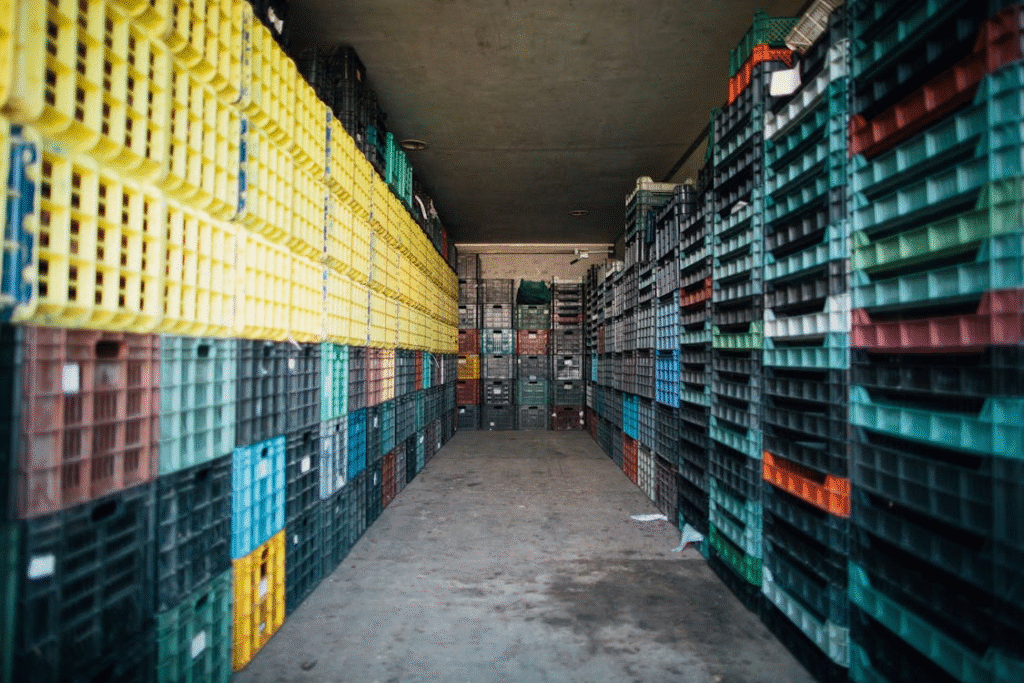If you’ve ever walked through a food factory or warehouse, you’ll know one thing: hygiene runs the show. It’s not a “nice-to-have” – it’s the rule that everything else depends on. From milk bottles and butter tubs to sacks of flour, every item that moves around a food facility needs to be handled in a way that keeps it clean, safe, and contaminant-free.
That’s why more and more companies are saying goodbye to old wooden crates and hello to plastic pallet boxes. It’s not about chasing trends – it’s about practicality.
The Hidden Problem with Wooden Boxes
Let’s be honest, wooden boxes have had their day. They were great when hygiene rules were simpler and expectations were lower. But today? Not so much.
Think about a wooden crate full of fresh produce. It’s been through cold storage, maybe a humid warehouse, or even an early morning delivery run. By the end of the day, that wood’s soaked up moisture like a sponge. You can scrub and rinse all you want, but water and everything it carries sinks deep into the grain.
That’s where bacteria love to hide. According to the European Food Safety Authority (EFSA), germs like Listeria monocytogenes and Salmonella can thrive on damp, porous surfaces. Wood practically rolls out the red carpet for them.
So even if a wooden box looks clean, it might not be. In food handling, that small risk can snowball into something serious – spoiled products, contamination, or even an expensive recall.
Why Plastic Just Works Better
Plastic pallet boxes might not sound exciting, but they’re changing the game for food businesses. They don’t absorb water, or grow mould, or they don’t even hold onto smells. You can pressure-wash them, steam them, disinfect them and they will come out spotless every time.
Most are made from HDPE (High-Density Polyethylene), a strong, food-safe plastic that stays tough whether it’s in a freezer or under the summer sun. They’re built to last, too and some boxes stay in circulation for years without cracking or wearing out.
And here’s the kicker: a lot of plastic boxes now have barcodes or RFID tags built in. That means every box can be tracked for – where it’s been, what it carried, when it was cleaned. Try doing that with a stack of wooden crates.

Everyday Life in the Food Chain
Visit any bakery or dairy plant and you’ll see the difference. Plastic pallet boxes stacked neatly in one corner, filled with dough, butter packs, or bottles of milk. They’re smooth inside, so nothing sticks – no crumbs, no residue, no lingering smells.
They also stack more securely, saving space and keeping storage areas safer. And in produce markets – where boxes get moved, tossed, and sometimes dropped – plastic wins again. It doesn’t splinter or warp. You get consistency, fewer damaged goods, and fewer injuries.
What About the Environment?
It’s a fair question – whenever plastic comes up, people instantly think bad for the planet, right? And in many cases, that’s true. But not all plastics are created equal. The ones used for pallet boxes are a different story altogether. Plastic pallet boxes are built to last – used, cleaned, and reused hundreds of times before they’re finally recycled into something new.
In fact, WRAP UK found that reusing tough, durable plastic packaging can cut down on both waste and carbon emissions across supply chains. And here’s something a lot of people don’t realize – many of the pallet boxes made today actually come from recycled materials. Old, worn-out boxes are ground down and reborn into new ones.
So yes, wood feels natural and looks eco-friendly on the surface. But when you think about how often wooden boxes need replacing and how much energy that takes plastic starts to make a lot more sense. A single heavy-duty plastic box can last for years, quietly reducing waste every time it’s reused.
The Bottom Line
In food handling, hygiene isn’t negotiable but it’s the foundation of everything. Plastic pallet boxes make it easier to keep things clean, organised, and safe without constant maintenance or risk. They’re durable, traceable, and better for the environment than most people think.
It’s one of those simple upgrades that makes a huge difference. Because sometimes, innovation doesn’t mean new technology – it just means using smarter materials for the job.
And when it comes to keeping our food safe, that’s a change worth making.
ALSO READ: Nomurano: A Destination, Philosophy, and Movement

